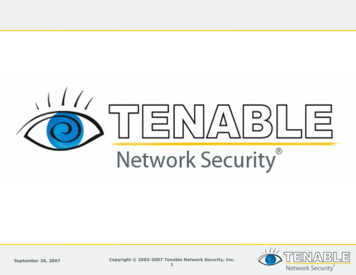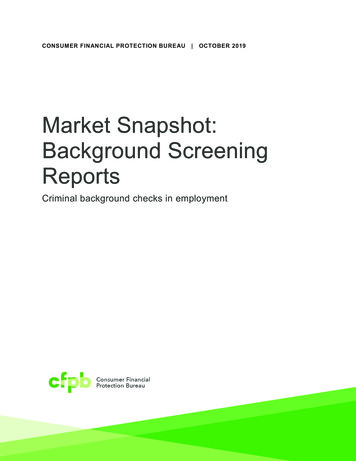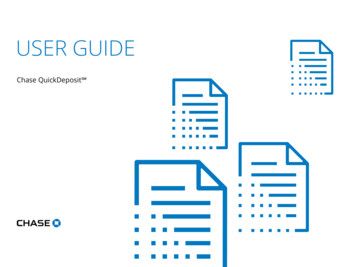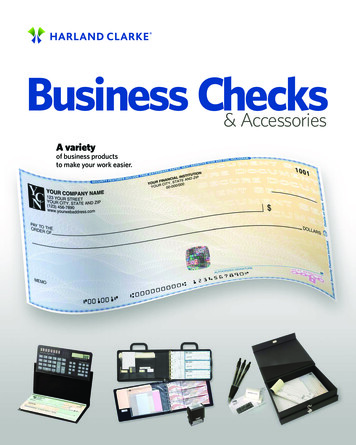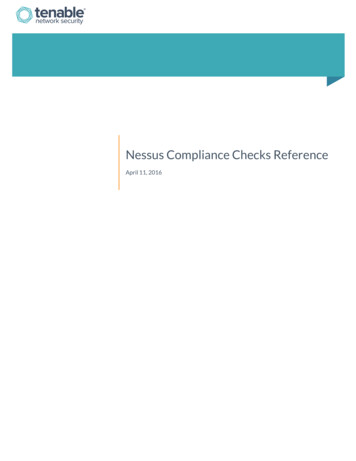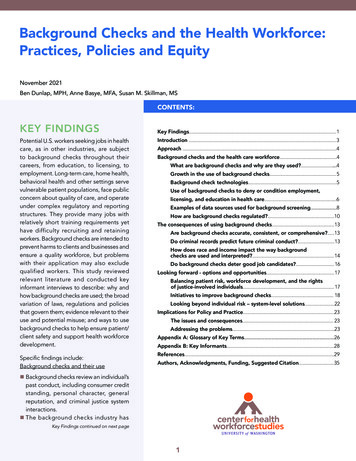
Transcription
Background Checks and the Health Workforce:Practices, Policies and EquityNovember 2021Ben Dunlap, MPH, Anne Basye, MFA, Susan M. Skillman, MSCONTENTS:KEY FINDINGSPotential U.S. workers seeking jobs in healthcare, as in other industries, are subjectto background checks throughout theircareers, from education, to licensing, toemployment. Long-term care, home health,behavioral health and other settings servevulnerable patient populations, face publicconcern about quality of care, and operateunder complex regulatory and reportingstructures. They provide many jobs withrelatively short training requirements yethave difficulty recruiting and retainingworkers. Background checks are intended toprevent harms to clients and businesses andensure a quality workforce, but problemswith their application may also excludequalified workers. This study reviewedrelevant literature and conducted keyinformant interviews to describe: why andhow background checks are used; the broadvariation of laws, regulations and policiesthat govern them; evidence relevant to theiruse and potential misuse; and ways to usebackground checks to help ensure patient/client safety and support health workforcedevelopment.Specific findings include:Background checks and their useKey Findings. 1Introduction . 3Approach .4Background checks and the health care workforce.4What are background checks and why are they used?.4Growth in the use of background checks. 5Background check technologies.5 Use of background checks to deny or condition employment,licensing, and education in health care.6Examples of data sources used for background screening.8How are background checks regulated?.10The consequences of using background checks.13Are background checks accurate, consistent, or comprehensive?.13Do criminal records predict future criminal conduct?.13H ow does race and income impact the way backgroundchecks are used and interpreted?. 14Do background checks deter good job candidates?. 16Looking forward - options and opportunities. 17Balancing patient risk, workforce development, and the rightsof justice-involved individuals. 17Initiatives to improve background checks. 18Looking beyond individual risk – system-level solutions.22Implications for Policy and Practice.23The issues and consequences. 23Addressing the problems.23Appendix A: Glossary of Key Terms.26Appendix B: Key Informants.28References.29Authors, Acknowledgments, Funding, Suggested Citation.35n Background checks review an individual’spast conduct, including consumer creditstanding, personal character, generalreputation, and criminal justice systeminteractions.n The background checks industry hasKey Findings continued on next page1
KEY FINDINGScontinued grown considerably, due to: the increased availability of private and government electronic databases, including criminaldatabases; few barriers to entry into the industry; and rising demand for services.n Federal and state regulations provide a variety of enforcement mechanisms to prevent misuse of background check information,but the time and resources required for implementation and related litigation blunt their effectiveness.Consequences of using background checksn Criminal involvement data obtained through background checks may be incomplete or inaccurate, lacking final dispositionsof charges or state-level conviction records, or drawing on incorrect name-based matches and uncorrected identify theft.n The evidence that background screening processes are effective is mixed. Some evidence links types of criminal historywith subsequent risk to clients/patients and to employers, but there is also research showing that, for example, a majorityof nurse aides found to have abused or neglected patients had no prior criminal history.n Research shows that, over time, the risk that a previously convicted individual will commit a new crime decreases, dependingon the type of prior crime, gender, and age at conviction. Eventually, an individual with a record poses nearly the same levelof risk for committing a new offense as an individual without one.n There is wide recognition that criminal records have a disparate negative impact on people of color and on lower incomeindividuals.nC oncern about background checks deters some job and education program applicants, despite the availability of appealsand individual reviews of disqualifying findings.n Criminal background checks as currently used may have limited efficacy in preventing harms to patients, may unnecessarilylimit the available health workforce, and, to the degree that they prevent employment, may contribute to recidivism.n Widespread use of background checks may be determined more by their convenience and low cost than by their effectivenessin reducing risk of harm.Looking forward – options and opportunitiesn Many initiatives are underway to adjust the balance between patient risk, workforce development, and the rights of justiceinvolved individuals. These include state and local legislative actions, litigation, and programs to help justice-involvedindividuals gain employment.n System-level solutions to prevent abuse and neglect of vulnerable patients and clients deserve more attention, such asaddressing low staffing levels and inadequate staff training in health care settings.Implications for policy and practiceTo address problems that result from using background checks, policymakers and users should consider the following guidelines:n Take into account the power differentials between those using background check reviews and those being reviewed.n Address the disparate impact of background checks on employment prospects for people of color and people with lowincome.n Remember that criminal records may contain important errors and omissions.n Resist the pressure to hire quickly – try not to skip over an applicant whose background check is taking extra time.n Incentivize employers to develop written policy to guide hiring managers and provide training for appropriate reviews ofbackground checks. Support measures that help employers interpret background checks accurately.n Consider both system-level and individual risk factors for harm in health care education, licensing and employment settings.n Identify and implement evidence-based programs that prevent abuse and neglect of vulnerable individuals.n Improve and increase use of bonding programs which insure employers hiring “high risk” employees.n Recognize that the likelihood of recidivism may decline over time.Background checks can be a tool to help protect vulnerable patients and clients while promoting access to a high-quality anddiverse workforce, but the drawbacks and potential harms of these checks need to be remedied.2Background Checks and theHealth Workforce:Practices, Policies and Equity
Background Checks and the Health Workforce:Practices, Policies and EquityINTRODUCTIONHealth care employers, regulatory agencies, and education programs in the U.S. frequently review information about anapplicant’s background before or after hiring, during professional licensing processes, or before acceptance to an educationalprogram and career path. Typically the information sought includes evidence of any prior convictions for a criminal offense,credit history, and verification of education and credentials, among other topics. Though these background checks may appearstraightforward, they rely on information from a variety of sources, and are governed by a complex regulatory environment.The internal policies of the organizations obtaining background screening information are shaped by relevant federal, stateand local laws and court precedent, as well as industry norms, all of which may vary by jurisdiction, professional licensingrequirements, and type of employment setting.The number of individuals under correctional supervision has grown over the past decades, particularly those released onparole and on probation in lieu of incarceration (Bureau of Justice Statistics, 2020; Shannon et al., 2017). In 2015, an estimated70 million people in the U.S. had an arrest or conviction record, and approximately 700,000 were released from incarcerationannually (S. Williams et al., 2016). The racial disparities in criminal records in the U.S. have also widened over time: between1980 and 2010, the estimated percent of African American adults with a felony conviction rose from 7.6% to 23%, comparedwith a rise from 2.5% to a little over 6% among the rest of the U.S. population (Shannon et al., 2017). In 2008, unemploymentamong all previously incarcerated individuals was 27%, while 43% of African American women with a record, and 35% of allmen with a record, experienced unemployment (Couloute & Kopf, 2018). Whether it is harder or easier for individuals withrecords to find employment during the COVID-19 pandemic is unclear. In the past, a high rate of unemployment, as seenat the start of the pandemic, disadvantaged individuals with records who were seeking work (Stabley, 2021). More recently,anecdotes of relatively strong hiring of individuals with records during the current pandemic can be found (Lee, 2021).The health care industry has a consistently high demand for workers, and most jobs in the field are considered to be of goodquality with employment benefits and opportunities for professional growth. It is important that the health care workforcereceive some initial and ongoing scrutiny during their employment to help ensure effective and safe environments for deliveringtheir care, especially because many individuals who receive health care (patients, clients, residents) have some kind of limitationor impairment that makes them particularly vulnerable. The background check is one tool used to select trainees, licenseesand employees that are perceived to be low risk to educational insititutions, licensing agencies, employers and their clients.Health care employees in the U.S. are subject to background checks throughout their career, from education, to licensing,to employment. In this report, we outline how background checks shape education, licensing and employment, with specificexamples from health care settings such as long-term care, home health settings and behavioral health. The report addressesthe following questions: What are background checks? What regulations and policies govern the use of background checks in general, and in health care settings? What are the ways in which the health workforce is affected by the use of background checks, especially in settings withvulnerable patients and a high demand for workers?3Background Checks and theHealth Workforce:Practices, Policies and Equity
How are policies for background checks changing, and how might these relate to health care settings? How can background screening be improved to help ensure patient safety and security, and strengthen the health careworkforce?By examining how background checks can affect patient and client safety as well as workforce development, this report offersinformation that may be used to improve how background checks are used in practice, and areas for future policy focus.APPROACHWe reviewed literature from scholarly databases and internet searches to identify relevant sources related to criminalbackground checks in general employment and in health care settings specifically, focusing on how they are used as employerrisk-mitigation strategies with the intent of preventing abuse and neglect of vulnerable individuals. We also conductedinterviews with six key informants, described below and in Appendix B.Our literature review included reports from national and regional organizations focused on improving the background checkprocess, relevant state and federal laws and regulations, congressional testimony, and programs that encourage the use ofbackground checks in health care settings with vulnerable adults, or that attempt to address ways for individuals who havehad contact with the criminal justice system to gain employment. We also examined peer-reviewed publications relevant tosafety, workforce development, and policy directions for background checks in the health workforce. In addition, we drewfrom recent work in Washington State, co-authored by two of this report’s authors, that addressed barriers to behavioralhealth employment related to criminal background checks (O’Connor et al., 2020).For this report, the study team selected key informants with expertise on the use of criminal background checks, as well asthe effects of these checks on the workforce, including advocates, legal experts and academics. Interviews were conductedusing a semi-structured interview guide for clarification and insights on these topics, and were transcribed and reviewedby the study team. The University of Washington Internal Review Board determined this study to be exempt from humansubjects regulations.BACKGROUND CHECKS AND THE HEALTH CARE WORKFORCEWhat are background checks and why are they used?Background checks are a review of information about an individual’s past conduct, often in the context of an applicationto an educational program, occupational license, or a job, and may also verify information reported by the applicant suchas their name, educational and training credentials, certifications, and other information relevant to the applicant selectionprocess. The information sources used vary and are described in greater detail below (see “Examples of data sources used forbackground screening”). Though there are many laws which reference and regulate the use of background checks, the U.S.Fair Credit Reporting Act (FCRA) provides some of the most detailed federal regulation of background screening processes(Federal Trade Commission, 2020). Within FCRA, background checks are referred to as “consumer reports” and are defined as: any written, oral, or other communication of any information by a consumer reporting agency bearing on aconsumer’s credit worthiness, credit standing, credit capacity, character, general reputation, personal characteristics,or mode of living which is to be used as a factor in establishing the consumer’s eligibility for – (A) credit or insuranceto be used primarily for personal, family or household purposes; (B) employment purposes; ("15 U.S. Code § 1681a- Definitions; rules of construction," 2020).Reasons for using background checks vary. Employers report using background checks, and identification of prior criminalhistories, to reduce risk of harm to clients and their business, reduce liability, and to meet regulatory requirements, among4Background Checks and theHealth Workforce:Practices, Policies and Equity
other concerns (HR.com, 2020). Stigma, an aversion to people with a criminal record independent of the conduct itself,may also be influencing how background checks are used during hiring decisions (Sugie et al., 2020). A U.S. GovernmentAccountability Office (GAO) evaluation of the 1993 Child Protection Act found that the deterrent effect of backgroundchecks (i.e., preventing some individuals with criminal records from applying to certain jobs) was an even more importantfunction for some hiring officials than obtaining results to use in hiring decisions (U. S. Government Accountability Office,1997). Athough the GAO’s report was limited to settings with children, employers’ use of background checks to deter certaintypes of applicants may be relevant in other settings as well.Growth in use of background checksCompleting a background check in a legally permissable way, and correctly using the information for hiring decisions, is acomplex task, particularly in the highly regulated health care sector (Snyder, 2020; Wells & Harrington, 2013). As a result,most background checks are completed by third party companies, such as consumer reporting agencies, that specialize inthese checks (Bushway & Kalra, 2021). An estimated 72% of colleges in the U.S. conduct background checks on applicants(Stewart & Uggen, 2020). The number of states using both name-based and fingerprint-based background checks duringoccupational licensing is growing (Murrin, 2019a, 2019b). In 2000, an estimated “70% of large companies and less than 20%of small to mid-sized companies” used background checks on new and current employees (HireRight, 2011). Since then,background checks have become nearly ubiquitous in hiring, with estimates ranging from 87% to 97% of U.S. employersusing criminal background checks (Nelson, 2019).The background check industry is large and there are no federal or state registration requirements for existing or newcompanies in this industry. In 2019, there were an estimated 1,954 background screening companies, and the two largestcompanies accounted for 14% of the industry’s revenue (Consumer Financial Protection Bureau, 2019). Today, the backgroundcheck industry collects 3.2 billion in revenue and is forecasted to grow 7.8% between 2019 and 2025 (Market ResearchFuture, 2021).Both employer demand and increased availability of data have contributed to the growth in the use of employment-relatedbackground checks. Employer concern about negligent hiring lawsuits may be one of the most important drivers of demandfor background checks (Bushway & Kalra, 2021). Social and legislative reactions to some high-profile crimes committed byindividuals with past arrests or convictions, including in health care settings, as well as the September 11th attacks, havealso contributed to the increased demand for background checks (Love & Schlussel 2020a; Travis, 2002). On the supplyside, Federal programs, state laws, and U.S. Supreme Court precedent made some types of court records, including arrestrecords, available online for free, and these have been turned into commercial products . Access to records has also becomeeasier as technological advances have reduced some of the costs of gathering, storing, and processing relevant information(Corda, 2016).Background check technologiesThe methods used by the background check industry are changing rapidly as companies apply new technologies toincreasingly detailed datasets about individuals. Twenty years ago, background checks were labor intensive and so only usedby those companies with resources and a perceived need. Technological and statutory changes have generally facilitatedaccess to criminal records, reducing the time and effort required to complete a criminal background check.Continuous background check services, also called “rap-back” services, proactively report new information about currentemployees or students to their employer or institution after the individual is hired or admitted (FBI Criminal Justice InformationServices Division, 2021). More recently, the application of artificial intelligence (AI) to large datasets has allowed backgroundcheck companies to more efficiently process and use detailed information about individuals to “continuously monitor”5Background Checks and theHealth Workforce:Practices, Policies and Equity
employees and assess for risks to client businesses. For example, Virginia-based software company Endera claims to use AIto continuously monitor “thousands” of datapoints about an individual employee in an effort to identify changes in risk to abusiness. Results can be tailored to specific industries concerned about specific types of worker behavior that may be perceivedas particularly risky given an individual’s position at a company. For example “[h]ospitals are seeking to screen employeesand patients for domestic abuse detection, which Endera identifies through divorce, restraining orders and citations” (Francis,2017). Other major companies that use AI include Chekr and Intelligo. While automated background check processes mayappear more efficient to hiring managers, admissions officers, and licensing agencies, they have also have raised concerns thatautomation may obscure flawed data or reproduce prohibited forms of discrimination (Eaglin, 2017; Martinez, 2020; Nelson,2019; Smith, 2020; U.S. Federal Trade Commission, 2016).Matching individuals to records in criminal databases involves a variety of technologies. State-based criminal records aretypically matched to an individual using the applicant’s name and date of birth. Background checks using the Federal Bureauof Investigation’s (FBI) national database are matched using fingerprints, perhaps the most well-known form of biometric (i.e.physical measurement) record matching. Other more sophisticated biometric matching technologies include photographicmatching against online photographs, and derived-data (e.g. “face-prints”) such as the commercially available service offeredthrough Clearview AI (Hill, 2021). Other matching technologies that rely on databases of human DNA are limited to criminaljustice activities and are not currently legal to use during hiring, licensing, or admissions decisions (LaMance, 2018; Shawneequaet al., 2010).Accurate record linkages are critical to match a student, license applicant, or job seeker to relevant records, if any exist. Whendone incorrectly, applicants may be matched with records that in fact refer to a different individual, and the applicant maybe unfairly excluded. This problem has led to lawsuits against background check companies by individuals seeking damagesfor lost employment opportunities (Nelson, 2019). State-based background checks, which typically use the candidate’s nameand date of birth to match records, may provide incorrect results for individuals with common names. Biometric means oflinking individuals to records, such as fingerprints, have the potential to be more precise in linking individuals to records, butalso may falsely associate an individual with prior criminal behavior. Though expectations of the databases might be quitehigh among the public and law enforcement, U.S. Senate testimony in the 2000s indicated that up to 50% of records in theFBI‘s fingerprint database were missing information about case disposition, (e.g. whether or not an arrest led to a conviction)(Nelson, 2019; Yu & Dietrich, 2012). The U.S. GAO has reported various efforts intended to remedy this issue such as theFBI’s Disposition Task Force in 2009, and Department of Justice’s assistance to states to improve record completeness (U. S.Government Accountability Office, 2015).The information returned by background screening companies varies and is not standardized. Reports from different backgroundcheck companies may vary by what data elements are included, how individuals are matched to records, accuracy, and thecompleteness of the records. These data sources are described in greater detail below.Use of background checks to deny or condition employment, licensing, and education inhealth careHealth care employers in the U.S. have considerable discretion in how they use background checks (Bushway & Kalra, 2021).They typically check backgrounds with the goal of ensuring patient safety, engendering trust and improving public perceptionsof professions and employers, and avoiding legal liability for the employer, such as negligent hiring charges. In educationalinstitutions, background checks are intended to prevent harm to both students and the institution. In health care education,the checks are frequently conducted to ensure students can meet requirements for clinical training in health care facilities. Instate licensing and credentialing processes, background checks can restrict practice to individuals deemed by authorities to6Background Checks and theHealth Workforce:Practices, Policies and Equity
have good character, including an absence of sometimes vaguely defined “crimes of moral turpitude”, in addition to meetingeducation and experience requirements.The use of background checks in health care is one of many ongoing efforts intended to prevent harms to patients in healthcare settings, and to help improve the quality of care in these settings. Public and government concern about harms to patientsin nursing homes and other long-term care settings have, since 1935, been periodically addressed in federal regulation,including in 1965 with the passage of the Medicare and Medicaid Acts (Institute of Medicine Committee on Nursing HomeRegulation, 1986). In 1983, only five states leveled a total of 376 criminal penalties for patient abuse (Institute of MedicineCommittee on Nursing Home Regulation, 1986). Reports from the Institute of Medicine (IOM) and other sources led toinclusion of language in the Omnibus Budget Reconciliation Act of 1987 barring individuals convicted of abuse or neglectof nursing home residents from working in nursing homes (Institute of Medicine Committee on Nursing Home Regulation,2001). In 2010, passage of the Affordability Care Act (ACA) ushered in new reforms, including a federal grant program tosupport states’ development of fingerprint-based national background checks for employment in long-term care settings,as well as requirements for health care employers to exclude job applicants who are listed on the Health and HumanServices Office of Inspector General’s (HHS-OIG) Exclusion List (Murrin, 2019a). HHS-OIG’s 2019 evaluation of 11 of the statesparticipating in the ACA background check program for long-term care facilities found that the number of determinationsof ineligibility varied among the states, from 0% to 3%. (Murrin, 2019b). While the evaluation noted that none of the statesreported unintended consequences associated with conducting background checks, such as reduced availability of longterm care workers, given the long-standing workforce shortages in these settings, it may be difficult to distinguish amongfactors affecting recruitment problems.Many workers in behavioral health occupations, which include professions providing mental health and substance use disorderservices, engage with vulnerable populations and are thus subject to background checks related to their employment.Individuals who have experienced and are in recovery from chemical dependency and addiction are sometimes the bestsuited to assist patients in recovery as substance use disorder professionals and peer counselors. These individuals in recoverymay also be more likely to have criminal convictions that stem from their addiction. If disqualified by background checksfrom the education, licensing and employment opportunities to become a behavioral health professional, the individual notonly is unable to leverage their adverse experience for their own career benefit, but access to beneficial services for clientsseeking recovery may also be reduced.Many jurisdictions have statutes or regulations which restrict employment for individuals with certain criminal records fromworking in some health care settings (Office of the Assistant Secretary for Planning and Evaluation, 2018). Other jurisdictions’courts have struck down prohibitions on employing individuals with criminal convictions on the grounds that these bans areunconstitutional (Langley, 2016). Guidance increasingly points towards careful assessment of an applicant rather than firmbans in health care settings (Office of the Assistant Secretary for Planning and Evaluation, 2018). This may be particuarlyrelevant for some occupations like peer counseling or forensic peer support specialists, whose own history of criminal justiceinvolvement becomes a tool they use to help clients with similar experiences in recovery and interactions with the system.Background checks may affect a career, including in health care, at any stage (Figure 1). Students, potential employees,recent hires, and existing employees may all be screened for criminal records or other potentially disqualifying history.During employment, licensing, or educational screening processes, a background check may reveal findings that disqualifya potential student or worker from education and employment.Although background checks may limit the number of candidates seeking employment, institutions and employers maysee these checks as protective against potential future litigation or damage to their reputation. From the perspective of the7Background Checks and theHealth Workforce:Practices, Policies and Equity
Figure 1: Criminal background checks may be conducted at any of the following pointsEducationLicensureEmployment Application to program Initial license application During application process Clinical training application “Good-character” requirements Continuous checks during employment Continuous checks during licensureapplicant with a criminal or arrest record, a requ
The University of Washington Internal Review Board determined this study to be exempt from human . Background checks are a review of information about an individual’s past conduct, often in the context of an application . 5 Background Checks and the Health Workforce:

